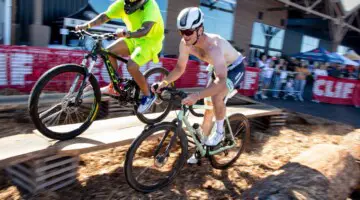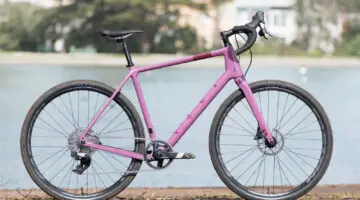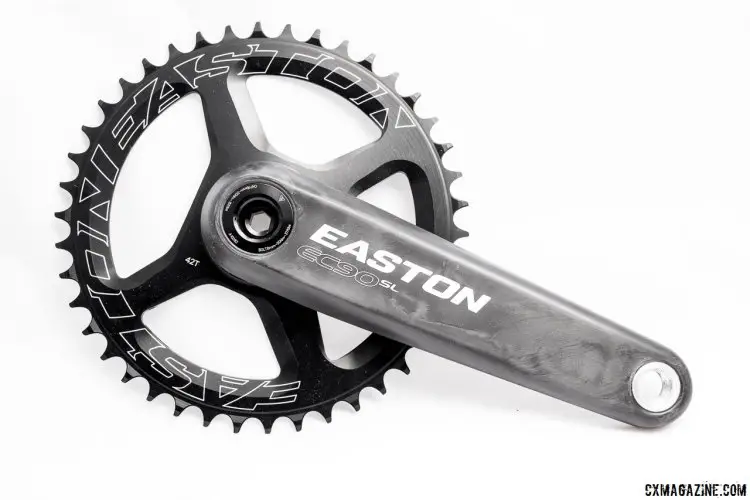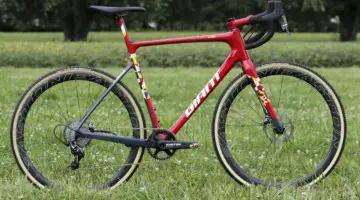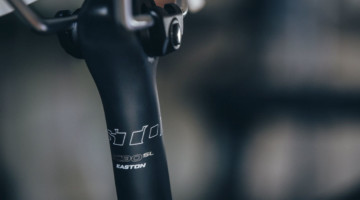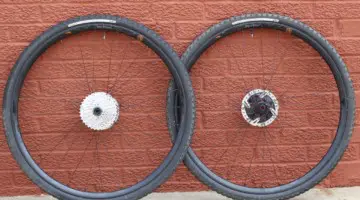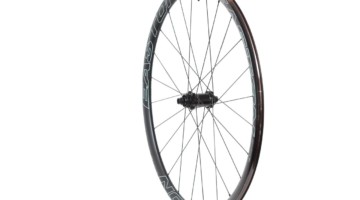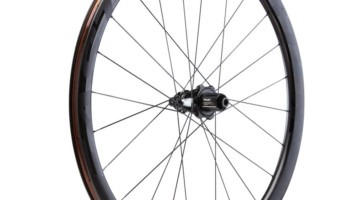On Monday Easton officially announced its new EC90 SL carbon crankset. This is not the first time Easton has made carbon cranks, with the sleek EC90 five-arm crankset released in 2009 (and surprisingly still available in places) being the last model we’ve seen. However, after stepping away from the crank market and later joining forces with Canadian component brand Race Face, Easton has leveraged the mountain bike brand’s lightweight NEXT crankset system to return to the market with an ultralight, versatile offering aimed at the cyclocross, gravel and road market.
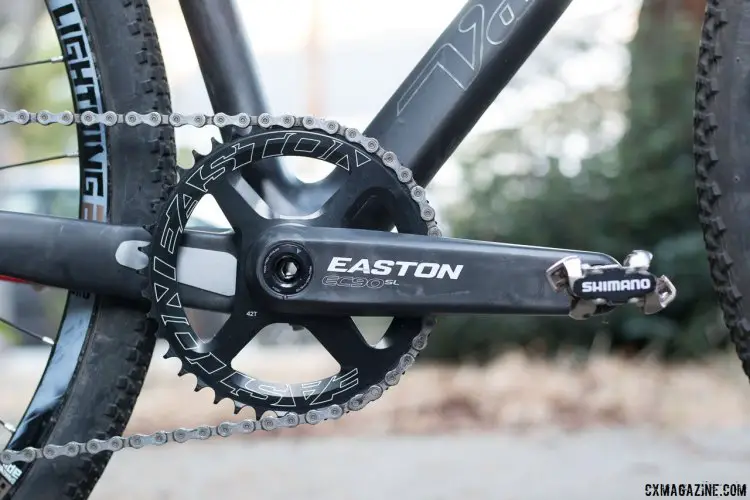
Ready to try 1x? Need a new chainring? Looking to save weight? Find changing chainrings to be tedious? Easton’s new EC90 SL carbon crankset could be the answer. © Cyclocross Magazine
We published technical details of the EC90 SL crankset on Monday, but we’ve been riding the crankset for a bit, and have some initial impressions, weight comparisons and specs for you here in Part Two of our coverage today.
Weight Weenies Rejoice
Easton boasts major weight savings of the Canadian-made crankset, which will be available in early August, but only a scale can verify if the claims are true and worth waiting for. I removed a relatively lightweight alloy Rotor 3D+ crankset, Rotor PF30 bottom bracket, 42 tooth Wolf Tooth Drop Stop chainring with alloy chainring bolts from a Van Dessel Full Tilt Boogie carbon frame. The system weighed a reasonable 754 grams.
The Easton EC90 SL crankset, 42 tooth chainring and Easton PF30 bottom bracket that would be replacing it? 578 grams.
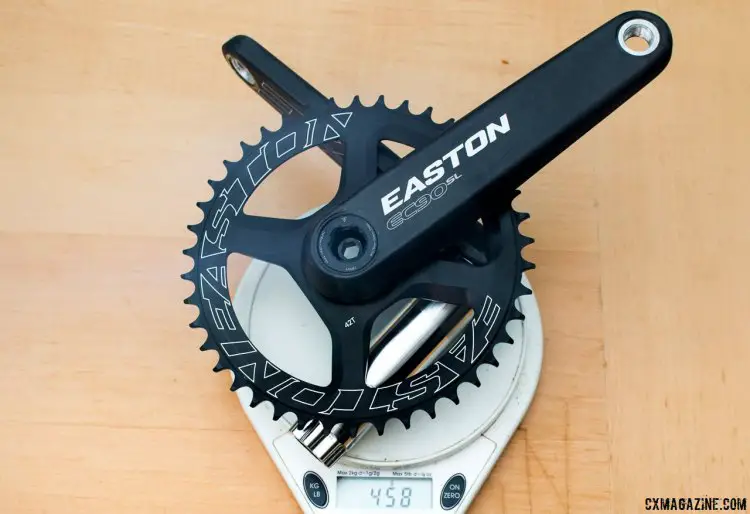
Easton’s new EC90 SL carbon crankset is gram saver at 458g without bottom bracket, and helped shed over 170g compared to a Rotor 3D+ crankset, bottom bracket and Wolf Tooth ring. © Cyclocross Magazine
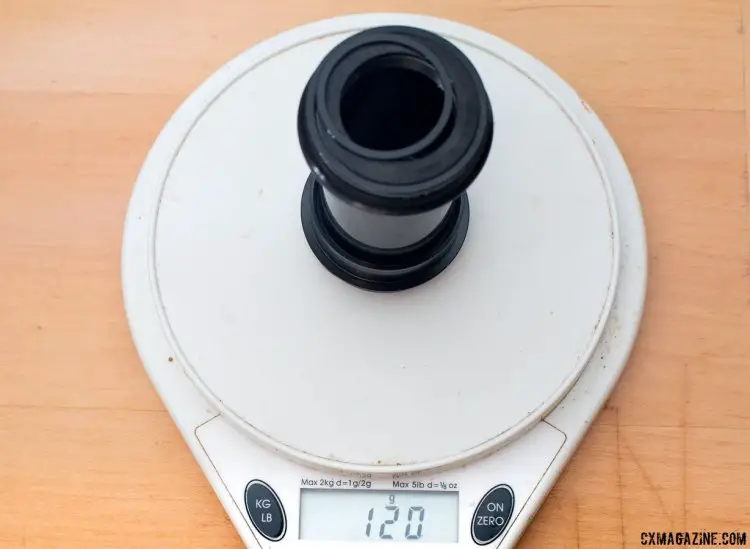
Easton’s new EC90 SL carbon crankset’s PF30 bottom bracket weighs 120g, which is not particularly light, but the few extra grams due to the alloy cups are worth it. © Cyclocross Magazine
I’ll do the math. That’s a 176g savings, or .39 of a pound. It’s also just over 100g lighter over a SRAM Force 1 PF30 setup, and about 100g lighter with a Easton BSA bottom bracket than a Shimano Dura-Ace crank and BB with a Wolf Tooth ring.
Weight savings typically come at a cost, and Easton’s setup will run you about $200 more than a SRAM Force setup (about $2/gram savings), but $200 less than the aluminum Rotor 3D+/Wolf Tooth combo that it replaced. (That’s comparing retail prices, but despite the EC90 SL crankset being not yet available, it seems like online retailers are already listing the crank arms at 15% off).
Installation and Swapping Rings is a Cinch
Easton calls its answer to SRAM’s Direct Mount system the Cinch System. And installation of the crank really is a cinch. Press in the aluminum cups with a bearing or headset press, push in the non-drive side crankset, attach the drive side crank with an 8mm Allen key, and then finger tighten the Cinch bolt on the non-drive side to preload the bearings and then lock it down with a 2mm Allen key. I expect that bearing preload adjustment to be invaluable in ensuring play-free performance over time.
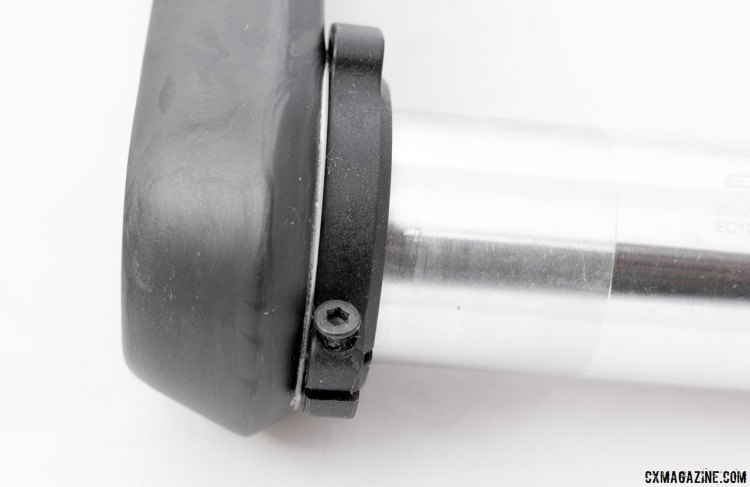
Easton’s new EC90 SL carbon crankset utilizes a hand-adjustable bearing preload dial that’s locked into place with a 2mm Allen key. © Cyclocross Magazine
Want lower or higher gearing for a gravel race, road ride or hilly cyclocross course? Swapping rings is faster than dealing with four or five chainring bolts, as you’re only dealing with two bolts, and none of them are at risk of spinning in place. Remove the right arm with an 8mm Allen key, use a 16-notch external BB bearing tool (like the Park Tool BBT-69) to remove the lockring, and pop a new chainring (or double) in its place. Of course you’ll need a front derailleur already set up if you want to switch between single and double chainrings, but as Craig Richey demonstrated in the (abbreviated) video here, chainrings can be swapped in under a minute.
Sink Your Uniquely-Shaped Teeth Into It
Take a close look at Easton’s wide/narrow chainrings, as the tooth profile is quite unique. They’re not like the squared-off teeth seen on SRAM’s X-Sync chainrings, and have a lot more shaping and material relief to their design.
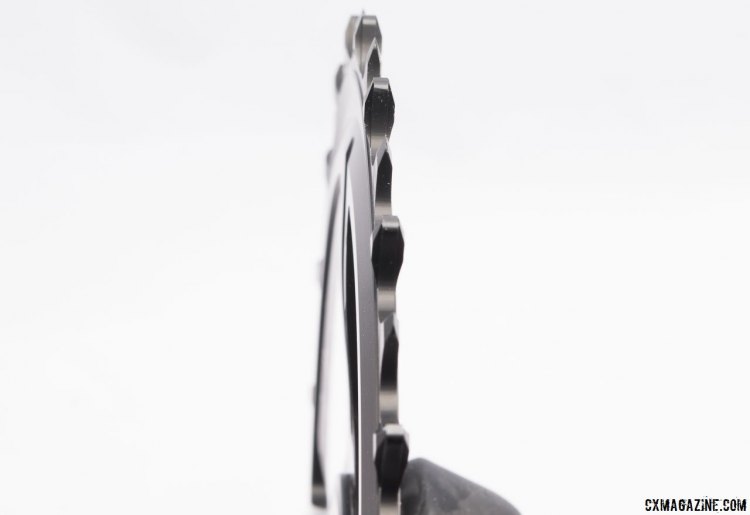
Easton’s wide/narrow chainrings feature a unique tooth profile with a noticeable taper. © Cyclocross Magazine
They’re also subtly hooked, although to my eyes, less so than an FSA Megatooth chainring.
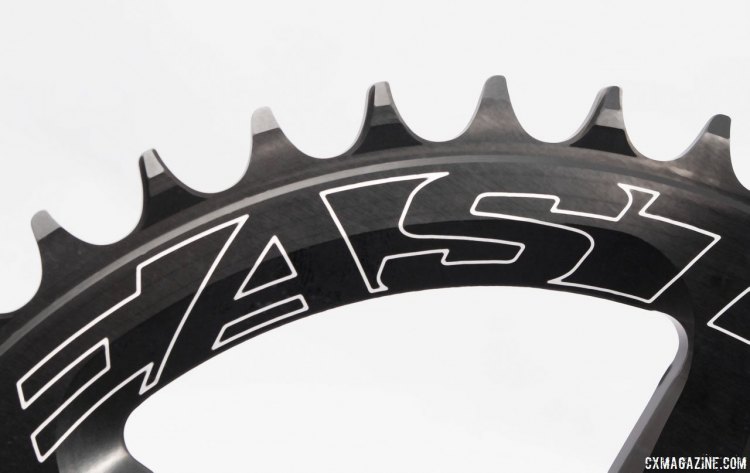
Easton’s new EC90 SL carbon crankset features a 1x wide/narrow chainring with slightly hooked tooth profiles. © Cyclocross Magazine
Easton explained the engineering behind the tooth profile to Cyclocross Magazine:
“Easton rings use a new narrow/wide design specifically tailored to road, cyclocross and gravel applications. The individual tooth profile has moved from the traditional symmetrical shape to a more directional specific design with the intention to create a positive chain roller engagement to help with chain retention, critical to prevent chain slip and bounce over rough terrain. Wide-tooth material has been removed from each side to reduce running noise and drag when running at extreme edges of the cassette. Additional material [was removed] at the base of the teeth, ensuring excellent mud shedding and chain retention in the muddiest of cyclocross conditions.”
The company claims that the tooth profile has such positive engagement that a clutch derailleur or a chain guard is unnecessary. While I haven’t tested this claim, as my initial tests of the crankset have been paired with a SRAM Force 1 rear derailleur, I’ve only derailed the chain once, and that was due to an errant stick getting jammed between the chain and the chainring—a freak occurrence for sure.
All Quiet on the Drivetrain Front
With two weeks of riding, I haven’t experienced any creaks or bottom bracket play, although I haven’t come close to cyclocross conditions yet. Knowing there are aluminum BB cups instead of plastic cups, and having easily-adjustable bearing preload provides some insurance against creaking and play in the future. In our book, that’s often worth the premium, even without any weight savings, over other creak-prone systems.
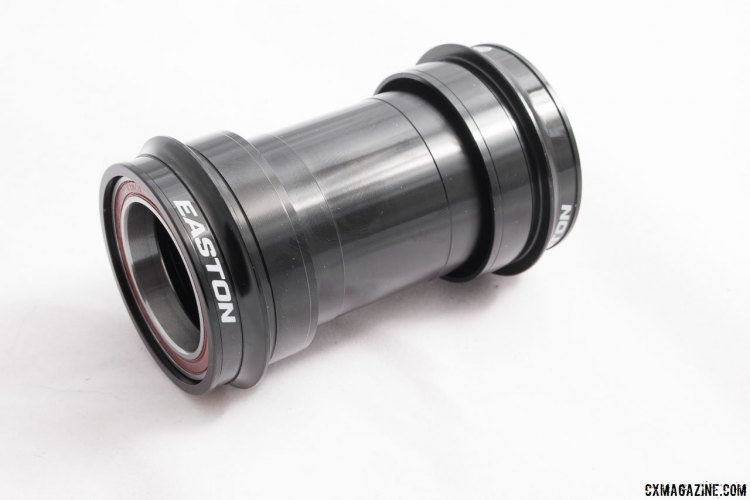
Easton’s new EC90 SL carbon crankset works with any modern BB configuration. Pictured is the 120g PF30 bottom bracket. No plastic cups here. © Cyclocross Magazine
The system, once installed, spun freely, more so than the typical OEM setups we’ve seen. This might be attributed to the ability to set bearing preload easily and precisely, the chainring tooth profile, or Easton’s bottom bracket bearings (or all three). The company says it paid extra attention to its seals, amount of grease and type of grease in attempt to optimize longevity and reduce friction.
The new bearing seal was designed to offer low drag but still fight contamination. Easton’s engineers subjected the bearings to a “24 hour continuous water invasion test” that essentially poured water onto the side of spinning bearings for an entire day. The results? The company says the seals proved “excellent contaminant exclusion.” It’s dry season here at headquarters, but I’ll be sure to power wash the bearings and see what happens in a tough cyclocross race environment.
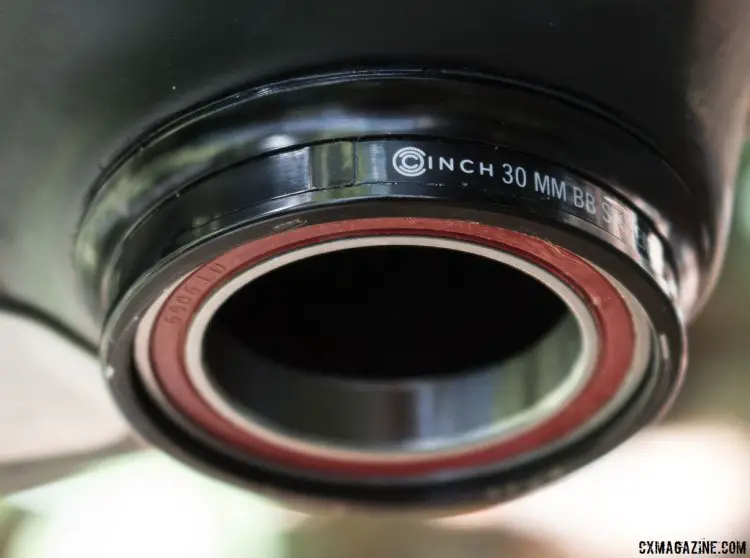
Easton’s new EC90 SL carbon crankset’s Cinch PF30 bottom bracket with low drag, water invasion-tested seals. © Cyclocross Magazine
Easton not only studied seals but grease too. No, the Canadians engineers didn’t go polar bear on us and left the friendly mammals alone. But in its tests, Easton found that not only grease viscosity but the amount of it made a difference. Instincts and habits might dictate slathering a ton of thick grease to ensure the best bearing longevity, but the company discovered that thick grease typically gets thrown by centrifugal force to the outer bearing race and stays there. A “correct level” of lower viscosity grease actually reduces friction and increases bearing longevity, according to Easton, and as you can imagine, that’s how the company ships its bottom bracket bearings.
In initial dry, dusty test rides, the difference in chain-related noise compared to our previous Rotor/Wolf Tooth combo seems minimal to my non-calibrated ears. If I were to guess, there might be a bit less noise when in the lowest gears (when running an 11-42 cassette), and just a tad more when not pedaling through bumpy terrain, as the relieved lower portion of a wide tooth allows a bit more wiggle (and perhaps less friction) than a typical wide/narrow ring.
Worth the Weight?
There’s no question about it. The EC90 SL is a lightweight, stiff crankset offering that should please serious cyclocross racers.
Not everyone can justify the $508 or so asking price for a crankset, when creative shoppers on a tight budget can put together a geared bike for that price. And even with the EC90 SL already being pre-sold at a discount, we can’t call the crank a bargain. But in a day when $2k wheels and $6k bikes are not rare in our sport, we see this crankset as a very competitive offering for any of the following groups:
- Weight-conscious racers
- Racers hand picking parts of their next race bike
- Chainring-changing racers looking for a more convenient, time-saving system
- One-bike diehards who want to switch between a single and double crankset
- Maintenance-overdue, creaky bike owners who need a new bottom bracket and replacement/additional chainring
- Chainline and friction-obsessed mechanics
- New single-ring converts
The price tag is certainly easier to swallow if you’re already needing to purchase a crankset, as the premium can be justified by the weight savings, convenience, potential lower maintenance and potential lower friction of the EC90 SL crankset and bottom bracket over other popular systems. Are those benefits worth scrapping a perfectly good crankset and bottom bracket to make the upgrade? Without a view into your wallet, we can’t say, but if you’ve initially slapped a random wide/narrow chainring on your old double chainring crankset, you’ll likely enjoy a better chainline and perhaps improved shifting in addition to gram savings.
Another way to look at the investment: Many cyclocross racers will spend $2k on a race day set of wheels and tires that saves 200g or less. Rolling resistance and rotating weight discussions aside, the Easton EC90 SL crank could save the same amount of weight (perhaps even more if you’re converting from a two chainring drivetrain) for less money, but you’ll enjoy the benefits on all your rides—not just race days.
Stay tuned for a longer-term test, after some racing, ring changing and power washing. Gallery below the specs table.
Easton EC90 SL Carbon Crankset Specs:
| BUILT FOR | ROAD / CX / TRI-TT |
| SIZE | 170-, 172.5-, 175mm |
| RING CONFIGURATIONS | 53/39, 52/36, 50/34, 47/32, 46/36, 46/30 w/ REMOVABLE SPIDER |
| SINGLE DIRECT MOUNT | 38T, 40T, 42T, 44T, 46T, 48T, 50T |
| WEIGHT | 590g 172.5mm 52/36 w/o BB 442g 172.5mm 40T w/o BB |
| CHAINLINE | 2x 43.5mm / 2x Disc 46mm / 1x 47mm |
| Q-FACTOR (WITH WASHERS) | 149mm |
| SPINDLE DIAMETER | 30mm |
| BB OPTIONS | BB86, BSA 68MM, PF30 68MM, BB30 68MM, BRIGHT, 386EVO, OSBB |
| MATERIAL | EC90 CARBON |
| FINISH | MATTE CARBON |
| MSRP | 1x Crankset without BB – $449 USD 2x Crankset without BB – $499 USD Single DM Rings $74 to $94 USD Bottom Brackets – $59 USD |
More info: eastoncycling.com
Easton EC90 SL Crankset, 1x Chainring and Bottom Bracket Photo Gallery:

